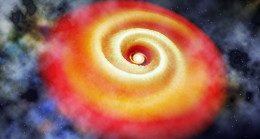It’s an old debate: gravity or companions? The spectacular spiral arms we see in some protoplanetary disks are likely caused by one or the other — and a recent study has taken a speedy approach to figuring out which.
What’s Driving Patterns?
Among the many swirling disks of gas and dust we’ve spotted around young, newly formed stars, more than a dozen contain a notable feature: large-scale spiral arms that can span tens to hundreds of astronomical units in size.

Artist’s impression of spiral arms in the disk surrounding a young star. [Institute of Astronomy, University of Cambridge — Amanda Smith & Farzana Meru]
Either way, the answer will reveal valuable information about the system. If the spirals are driven by a gravitational instability, then we can constrain the mass of the disk. If they’re caused by the interaction of the disk with a planetary companion, we can infer the mass and location of the planet.
Past explorations of spiral arms have focused on examining static observations of disks. But a team of scientists led by Bin Ren (California Institute of Technology) has now taken a different approach, instead looking at how the arms of one disk move over time.
A Need for Speed … Measurements
Ren and collaborators gathered Very Large Telescope SPHERE observations of MWC 758, a young star and spiral-armed disk located just over 500 light-years away, spanning a baseline of nearly five years. They then fit models to MWC 758’s spiral arms to establish their pattern speeds — the angular speeds at which the arms are rotating.
The authors were looking for one of two potential outcomes linked to the origin of the arms:
- If driven by a gravitational instability, the material of the arms will move at the local Keplerian speed, set by the mass of the central star. This means the inner parts of the arms will move quickly and the outer parts more slowly, winding the arms up ever more over time.
- If driven by a planetary companion, the arms will move as a solid structure that matches the speed of the companion.
Time for Planet Hunting

The best-fit circular orbit of a planetary companion driving MWC 758’s spiral arms lies at ~170 au for a 1.9-solar-mass central star. [Ren et al. 2020]
Based on imaging of the disk, the authors set upper limits of about 5 Jupiter masses for the hidden planetary companion that’s driving the arms. The MWC 758 system makes an ideal target for future observations with current and upcoming telescopes to try to spot the planet driving its arms — especially now that we know where to look!
Citation
“Dynamical Evidence of a Spiral Arm–driving Planet in the MWC 758 Protoplanetary Disk,” Bin Ren et al 2020 ApJL 898 L38. doi:10.3847/2041-8213/aba43e


3 Comments
Pingback: From AAS NOVA: “Checking the Speed of Spirals” | sciencesprings
Pingback: Sprawdzanie prędkości ramion spiralnych dysków protoplanetarnych – PTMA Kraków
Pingback: Sprawdzanie prędkości ramion spiralnych dysków protoplanetarnych – Astronomia Śląska